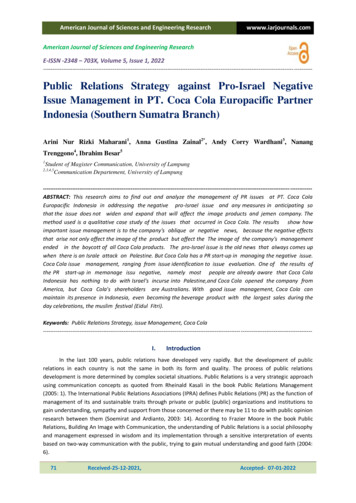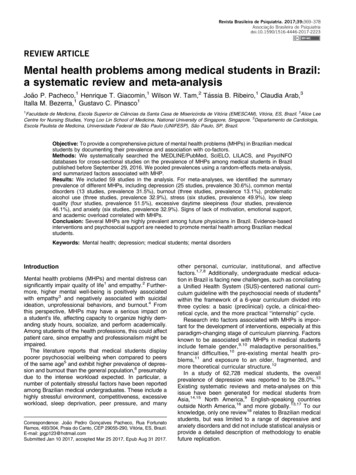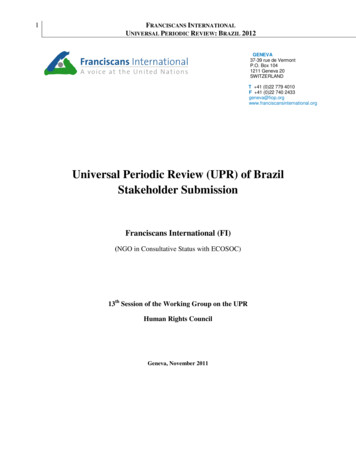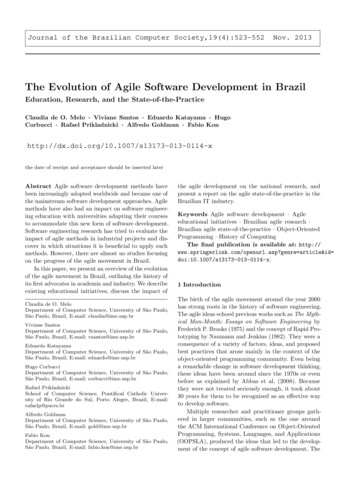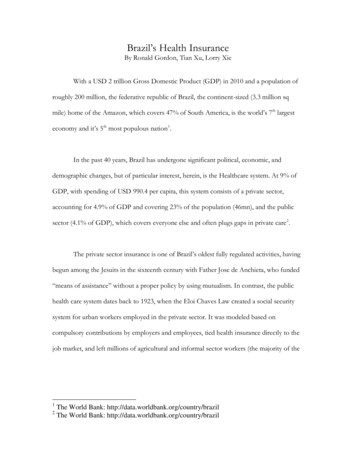
Transcription
Marcio SiwiU.S. –Brazil Cultural Relations during World War II“Our two countries could have a better relation after our marriage”-“Showman” Rudy Vallee and Carmen Miranda in May 1941 during theRoyal Gelatin ProgramIn the 1940s, many Americans started their day with a strong cup of Brazilian coffeeand turned their radio dial to the Rudy Vallee Show to hear Carmen Miranda, “the-lady-withthe-tutti-frutti-hat”, sing Chica Chica Boom Chic and other lively sambas. Walt Disney’sanimated films such as Saludos Amigos and Three Caballeros also gave American audiencesentertaining vignettes of Brazilian society and culture. And among sophisticated audiences,Brazilian painter Candido Portinari was hailed as one of the most audacious artist of his time.But Americans weren’t the only ones being exposed to foreign customs, Brazilians too werebecoming increasingly aware of American society and culture during this period. WhileHollywood films, American popular music and Coca-Cola were becoming common featuresof Brazilian daily-life, Brazilians were also beginning to incorporate quintessential Americanmannerisms such as “thumbs up” and expressions like “OK”, “good night” and “I love you”.In short, Brazilians and Americans were well on their way to becoming close friends andallies.This increased cultural exchange was not only a popular, and commercial phenomena,but also a concerted effort on behalf of both countries to use culture as a strategic foreignpolicy tool. Based on the premise that mutual understanding and goodwill leads to successfuldiplomacy, both governments, especially Franklin Roosevelt’s administration, allocated largeamounts of resources to the expansion of culture and information abroad. Created in 1940and led by Nelson Rockefeller, the Office for the Coordinator of Inter-American Affairs1
(OCIAA) was the main agency in the U.S. government in charge of crafting cultural policies.The OCIAA cultural programs were designed with two main goals in mind: to feed Brazilianaudiences positive images of American society and, more importantly, to counteract Nazipropaganda in Brazil and the rest of Latin America. Meanwhile, in Brazil, Vargas created theDepartment of Information and Propaganda (DIP) in order to craft cultural policies designedto enhance the legitimacy of the Estado Novo regime both at home and abroad. The DIP alsogave Getulio Vargas an opportunity to project an image of a modern and stable Brazil toaudiences in the United States that were growing increasingly worried over the directionBrazil had taken since the rise of the Estado Novo dictatorship in 1937, particularly Vargas’flirtations with Nazi Germany. Although each country’s cultural policies were designed to fittheir own specific agendas, they did nevertheless manage bring the U.S. and Brazil closertogether during the war. However such programs also provoked harsh reactions amonginfluential groups in both countries, so much so that soon after the war ended, bothgovernments were forced to abandon cultural activities all together.Conflicting Dialogues: the Good Neighbor Policy and World War IIPresident Franklin Roosevelt formulated the Good Neighbor Policy as an attempt toset U.S. - Latin American relations on a new and different path, away from the interventionistpractices of the past and into an era of mutual respect and understanding. Roosevelt made hisintentions clear when he promised to institute “a policy that is respectful of the rights of ourgood neighbors. Good Neighbors should comply with agreements and respect treaties.”1Moreover, in 1933, at the Pan-American conference in Montevideo, Secretary of State Cordell1Thomas Peterson, J. Garry Clifford & Kenneth J. Hagan American Foreign Policy – ahistory – since 1900 Lexington DC, Health and Company, 1983.2
Hull assured his audience that “no state has the right to intervene in the internal or externalaffairs of any other nation.”2However, by the late 1930s it had become clear that the war in Europe couldpotentially spill over to the Western Hemisphere and threaten U.S. national security interests.The U.S. government was faced with a hard choice: whether to honor the principles of nonintervention characterized by the Good Neighbor Policy, or act more assertively to neutralizethe threat. Fearing that Japanese and German expatriates in Latin America made up a “fifthcolumn”, the United States government reached into fifteen Latin American countries, seizedmore than 4,000 of these expatriates, and locked them up in internment camps in Texas.3Brazil, however, was not one these countries, despite the fact that it was home to a largenumber of Germans and Japanese alike. Strategically too important for the United States torisk loosing it to the Germans as the result of American aggression, the U.S. was forced tofind a different, less aggressive, way to deal with Brazil. Nevertheless, coercive methodssuch as spying and even military action were options that the United States government onlyabandoned in 1942, when Brazil joined the allies in the war against Nazi Germany.4Given the relatively short distance between Northwest Africa and the BrazilianNortheastern coastline, the United States government needed the full support of the Braziliangovernment if it was to confront the Axis in North Africa and prevent the Nazis frominvading the Western Hemisphere via Brazil. 5 Consequently, Northeastern Brazil became of2Thomas Peterson, J. Garry Clifford & Kenneth J. Hagan American Foreign Policy – ahistory – since 1900 Lexington DC, Health and Company, 1983.3Max Paul Friedman Nazis and Good Neighbors : The United States campaign against theGermans of Latin America in World War II. Cambridge University Press, UK 2003.4Antonio Pedro Tota O Imperialismo Sedutor: A Americanização do Brasil na época daSegunda Guerra Companhia das Letras, 2000. Pp 179-1815Moniz Bandeira Presença dos Estados Unidos no Brasil: Dois Séculos de HistoriaCivilização Brasileira, 1973. Pp. 2703
great geo-strategic importance to the U.S Army. Proximity to Northern Africa, however,wasn’t the only advantage or worry that Brazil had to offer. Brazil was also home to one ofthe world’s richest deposits of iron ore, manganese, nickel, uranium, rubber and otherstrategic materials that were in great demand during this period as nations around the worldbuilt their armies for the war. Still, the Brazilian government was less then enthusiastic aboutgranting the United States permission to establish military bases in the Northeast, or theprospect of entering into an exclusive commercial agreement with the U.S., especially sinceleading officials in the Brazilian government were more impressed with Germany’s militaryprowess and economic vitality. 6With the military option virtually off the table, the United States government set out topersuade a reluctant President Getulio Vargas to cut off all ties with Nazi Germany and jointhe allied forced. Aside from showering the Brazilian government with generous loans,economic aid, favorable trade deals and armaments, FDR firmly believed that U.S. nationalsecurity also depended on the government’s ability to export American culture andinformation to Brazil. Consequently, the fact that many Brazilians harbored a negativeopinion of the United States during this period made FDR’s call for greater cultural exchangeeven more prescient. Americans were generally regarded as arrogant and aggressive peopleswho looked down upon Brazil and the rest of Latin America. Additionally, many Braziliansbelieved Americans were culturally naïve, and a society that was marred in racial conflictsand driven by greedy capitalists. 7 Although widespread, anti-Americanism wasn’t the onlyissue concerning the United States in the run up to World War. Politicians in WashingtonMoniz Bandeira Presença dos Estados Unidos no Brasil: Dois Séculos de HistoriaCivilização Brasileira, 1973. Pp. 2547Antonio Pedro Tota O Imperialismo Sedutor: A Americanização do Brasil na época daSegunda Guerra Companhia das Letras, 2000.64
were also exceptionally nervous about the aggressive propaganda campaign mounted by NaziGermany in Brazil and the rest of Latin America.By the late 1930s, Germany and Japan had not only successfully banned all Americanmovies and other cultural goods from entering their territory, they had also revolutionized theuse of mass communication and launched media offensives that paralleled their militarystrength.Germany was actively promoting Nazi documentary films and building high-powered radio transmitters to broadcast Nazi programs to Brazil and the rest of LatinAmerican.8Consequently, the U.S. government feared that Nazi propaganda couldpotentially mobilize sympathizers in the German colonies in Southern Brazil as well as theGermanophiles inside the Brazilian government and military.Not surprisingly, whenWashington finally set up the first official cultural exchange agency within the StateDepartment in 1938, its activities were designed to offset Nazi propaganda in Brazil withpositive images of American culture and the message of inter-American solidarity.Nelson Rockefeller and the rise of the Office of Inter-American AffairsEarly in the 20th century, private foundations, businesses and missionaries were themain representatives of American cultural values in Brazil. Together with local organizationsand state governments, American interlocutors such as The Carnegie Endowment forInternational Peace, The Institute for International Education and The Rockefeller Foundationsupported cultural and technical assistance programs in health care, education, and the arts.9These organizations provided the kind of constructive presence in Brazil that many in the U.S.government believed essential for successful diplomacy and U.S. national security. However,8Irwin F. Gellmen Good Neighbor Diplomacy: United States Policies in Latin America, 1933– 1945. John Hopkins University Press, Baltimore and London, 1979. Pp. 1469Irwin F. Gellmen Good Neighbor Diplomacy: United States Policies in Latin America, 1933– 1945. John Hopkins University Press, Baltimore and London, 1979. Pp. 1435
the stock market crash of 1929 and the depression that followed significantly weakened theseinstitutions and, as a result, American presence in the region was greatly reduced. In effort toreinstate America’s presence in Brazil, FDR and others pressed the U.S. government to bemore directly involved in cultural expansion.Although vehemently opposed by congress, in 1938 FDR finally managed to set upthe first official cultural agency within the State Department. With the creation of Division ofCultural Relations (CR) policymakers began to craft cultural policies compatible with largerstrategic foreign policy goals and American values such as free market, capitalism,consumerism, individualism, democracy and freedom. Despite the lack of political support inthe Congress, and its limited budget of 75,000 dollars, CR sponsored student andprofessional exchange programs, organized art exhibits, built American libraries and othercultural centers in Brazil. However, the full implementation of FDR’s vision of effective,government led, cultural programs designed to counteract Nazi propaganda was only achievedwith the creation of a new government agency headed by Nelson Rockefeller, an influentialoutsider, major campaign donor, and staunch supporter of FDR’s strategic use of Americanculture.In 1939, on a business trip to Latin America to oversee the operations of Standard Oil,Nelson Rockefeller became alarmed by the growing Nazi influence in the region.Unimpressed with the performance of the Division of Cultural Relations, he encouraged FDRto create an agency entirely dedicated to spreading pro-American information in LatinAmerica, specifically Brazil. After battling Secretary of State Cordell Hull for months, FDRfinally succeeded and, with an order from the Council of National Defense, the Office forCoordination of Commercial and Cultural Relations between the American Republics was6
created in August of 1940.10 To serve as director, FDR appointed his loyal friend NelsonRockefeller. The name of the agency would change a few times over the years but, by the endof the war, it was known as the Office of the Coordinator of Inter-American Affairs (OCIAA).And although the OCIAA had an initial budget of 3.5 million dollars in 1940, once the U.S.officially entered the war, FDR tapped into the Presidential Emergency Fund and raised it to 45 million, giving Rockefeller and his staff unprecedented amounts of resource and power toreshape America’s cultural industries. 11According to Brazilian historian Antonio Pedro Tota, the OCIAA was tantamount toan “ideology factory” for the way Rockefeller and his staff carefully packaged and soldpositive images of the United States to Brazil. Similarly, in an effort to reduce undue tensionbetween the two countries, the OCIAA also worked to improve the way Brazilians (and otherLatin Americans) were represented in the American media. Organized in three main divisionsor sections - The Film Section, The Press Section, and The Radio Division - the OCIAA alsosupported various technical assistance programs, scholarly and artistic exchange, andsupervised official visits by prominent intellectuals and celebrities.In the 1930s, most American films shown abroad presented a hostile picture of theUnited States, emphasizing gangsterism, corruption and other negative aspects of Americanlife, including racial tensions.12 In addition, the characterization of Brazilians and other LatinAmericans in most Hollywood movies also troubled the OCIAA. Usually depicted as lazyvillains and other undesirables, the portrayal of Latin Americans in Hollywood during the10Irwin F. Gellmen Good Neighbor Diplomacy: United States Policies in Latin America,1933 – 1945. John Hopkins University Press, Baltimore and London, 1979. Pp. 14911Emily s Rosenberg Spreading the American Dream: American Economic and CulturalExpansion, 1890-1945 Hill and Wang, New York 1982. Pp. 20212Antonio Pedro Tota O Imperialismo Sedutor: A Americanização do Brasil na época daSegunda Guerra Companhia das Letras, 2000.7
1930s reinforced negative stereotypes and fostered resentment in the Americas. Moreover,American movies were also notorious for being culturally incoherent: Brazilians often spokeSpanish as opposed to Portuguese and sang Rumba instead of Samba. According to AntonioPedro Tota, Hollywood’s ignorance about Brazil and Latin America tended to unleashedminor diplomatic storms.13Fearing that Hollywood’s negative portrayal of American andLatin American societies could potentially worsen U.S. reputation in the WesternHemisphere, the Film Section set out to harness the seductive power of American movies toproject a more favorable image of the United States and American culture in general.In an effort to mitigate the effects of these negative portrayals and damagingconfusions, the Film Section gained complete oversight of every American movie sent toBrazil. Even though the Film Section reserved the right to censor movies sent abroad, only afew were actually banned. The main effort was to convince the studios to be more patriotic intheir depiction of American society and informed about Latin America. To this end, the FilmSection effectively persuaded Hollywood studios to re-edit scenes that Latin Americanaudiences might find objectionable. On one particular occasion, the producers of DownArgentine Way, a 1940 film directed by Irving Cummings staring Betty Grable and CarmenMiranda, spent an additional 40,000 dollars to re-shoot scenes that the Film Section founddistasteful.14Rockefeller’s personal relationships with movie executives in Hollywood greatlyenhanced the effectiveness of The Film Section. Consequently, Hollywood studio were morewilling to acquiesce to the OCIAA’s various demands, which also included the casting of13Antonio Pedro Tota O Imperialismo Sedutor: A Americanização do Brasil na época daSegunda Guerra Companhia das Letras, 2000.14Emily s Rosenberg Spreading the American Dream: American Economic and CulturalExpansion, 1890-1945. Hill and Wang, New York 1982. Pp. 2078
Latin American actors and the addition of scenes of famous sites in Rio de Janeiro and otherparts of Latin American. The close relationship between Nelson Rockefeller and movieproducers in Hollywood also paved the way for the rise of Carmen Miranda, the Portugueseborn singer and actress, who dazzled American audiences during the1930s and 1940s with herunique and sensuous representation of Brazilian culture. Carmen Miranda went on to becamenot only the most popular Brazilian in the U.S., appearing in numerous Broadway musicals,Hollywood movies and radio shows, but also the highest paid female artist of her time.15Another achievement of the Film Section was Rockefeller’s ability to convince WaltDisney and his team of animators to go on a fact-finding trip to South America, includingBrazil, with the intention of creating the first “Good Neighbor” movie. Disney’s unwaveringsupport for FDR’s call for greater inter-American solidarity led to the creation of SaludosAmigos and Three Caballeros which starred a new Brazilian character, a green and yellowparrot called Ze Carioca, who became Donald Duck’s loyal friend in his travels through Riode Janeiro and Bahia. Moreover, the soundtrack to Saludos Amigos featured Brazil (Aquarelado Brasil), a samba by the famed Brazilian composer Ary Barroso, which, like the movie,became an immediate hit in the U.S. Carmen Miranda, Ze Carioca and other promoters ofBrazilian culture in the U.S. during 1940s provided a warm and welcoming quality to FDR’sGood Neighbor Policy.The Film Section also produced newsreels and documentaries, both in Portuguese andEnglish, to showcase Brazil’s important contributions to the war effort. Filmed in 1943, thedocumentary Brazil Quartz goes to War shows how Brazilian minerals helped build airplanes15Daryl Williams Culture Wars in Brazil: The first Vargas Regime, 1930-1945 DukeUniversity Press, Durham & London 2001. Pp. 2009
and radio transmitters used by the U.S. Air Force.16 Brazil gets the News and Brazil’s FishingSchools along with other short films offered American audiences glimpses of a country thatwas both modern and rich in cultural tradition.17 The Newsreel Section also hired well-knownAmerican directors such as John Ford and Orson Wells to make documentaries in Brazil tosupport OCIAA’s mission. Although Wells’ documentary film project was never finished,like most of the material coming out of the OCIAA’s Film Section, It’s All True gives viewersa generally positive impression of Brazil.When Nelson Rockefeller tried to persuade the Associated Press and United Press toproduce more Brazil and Latin America related news stories, AP and others declined hisrequest on the basis that their readers were not interested in the region.18 Aside from the lackof Brazil related material, most American news agencies shared Hollywood’s stereotypicalportrayal of Latin Americans as lazy, backwards and/or sexually charge individuals. In orderto give American audiences a more accurate, if not favorable, treatment of Brazilian societyand Vargas’ administration, Rockefeller set up a Press Section within the OCIAA. One of thelargest divisions of the OCIAA, the Press Section supplied wire services with news stories,photographs, cartoons and other relevant material.19Pressuring North American mediaoutlets to be more fair and balanced in their reports on Brazil and the rest of Latin Americawas just as important for the Press Section as changing the reporting habits of LatinAmericans themselves.16Antonio Pedro Tota O Imperialismo Sedutor: A Americanização do Brasil na época daSegunda Guerra Companhia das Letras, 2000. Pp. 6817Antonio Pedro Tota O Imperialismo Sedutor: A Americanização do Brasil na época daSegunda Guerra Companhia das Letras, 2000.18Irwin F. Gellmen Good Neighbor Diplomacy: United States Policies in Latin America, 1933– 1945. John Hopkins University Press, Baltimore and London, 1979. Pp. 15119Antonio Pedro Tota O Imperialismo Sedutor: A Americanização do Brasil na época daSegunda Guerra Companhia das Letras, 2000. Pp. 6010
Early in the war, only a handful of Latin American publications reported the successesof the allies or the activities of the U.S. State Department. Instead, headlines of Hitler andMussolini dominated the front pages of most newspapers. 20 Consequently, the Press Sectionembarked on a campaign to persuade Brazilian magazines and newspapers to print proAmerican stories and, as an incentive, the OCIAA offered subsidies to sympatheticpublications.The Press Section also published its own magazine called Em Guarda, aPortuguese language publication, patterned after Life Magazine that was filled with storiesabout the allied forces as well as the Brazilian contributions to the war effort. Seleções wasanother popular OCIAA magazine which offered Portuguese translations of The Reader’sDigest. Seleções also gave Brazilian readers access to articles from The Nation, The NewYork Times Magazine, Harpers and many other liberal publications from the United States.Em Guarda and Seleções enjoyed a wide readership in Brazil, making them very attractive toAmerican companies seeking to sell products like refrigerators, washing machines, blenders,Coca-Cola and cars to Brazilian consumers.21 Advertising the advantages of the “Americanway of life” was an integral part of the OCIAA’s mission in Brazil. So much so, thatcompanies that advertised on OCIAA publications were not only praised for their patriotism,but also rewarded with tax breaks.22During World War II, many countries, including the United States, got involved inforeign language broadcasting and competed with each other to promote their programsabroad. In Brazil, the battle over the airwaves was waged between the U.S. and Germany.20Irwin F. Gellmen Good Neighbor Diplomacy: United States Policies in Latin America,1933 – 1945. John Hopkins University Press, Baltimore and London, 1979. Pp. 15121Antonio Pedro Tota O Imperialismo Sedutor: A Americanização do Brasil na época daSegunda Guerra Companhia das Letras, 2000. Pp. 5722Irwin F. Gellmen Good Neighbor Diplomacy: United States Policies in Latin America,1933 – 1945. John Hopkins University Press, Baltimore and London, 1979. Pp. 15211
The Germans were in the lead in 1939, beaming over nine hours of programming a week.23Working closely with private commercial stations, the Radio Division of the OCIAAbroadcasted official speeches, educational programs, music shows and news programs toBrazil and the rest of Latin America. Although private networks such as NBC and CBS wereinitially reluctant to join the government’s effort to invest on international transmissions,Nelson Rockefeller’s close ties with radio executives was instrumental in changing theirminds. The partnership between the OCIAA, American broadcasters and eventually the DIPproved to be a highly productive one. By the end of 1941, after the attack on Pearl Harbor,the United States surpassed German broadcasters and was beaming everything from newsshows to music programs to Brazil around the clock. Brazilian listeners could hear shows likeAs Nações Unidas Falam (the allied Nations Speak), Estamos Em Guerra (We are at War), aswell as Bob Ripley’s Believe it or Not – all of which were either scripted or adapted by theOCIAA’s Radio Division.24 Aside from conveying an attractive image of American society,these programs emphasized America’s military might, both material and moral, and its abilityto defeat the Axis.American audiences were also being exposed to Brazilian news and popular cultureduring the 1940s. NBC’s evening broadcast called News of the World with co-hosts DrewPearson and Bob Allen had a Latin News section dedicated almost entirely to Brazilian newsand analysis. News of the World also featured prominent political figures, including FranklinRoosevelt, who on occasion sent warm and encouraging messages to Brazil, “our largest23Irwin F. Gellmen Good Neighbor Diplomacy: United States Policies in Latin America,1933 – 1945. John Hopkins University Press, Baltimore and London, 1979. Pp. 15224Antonio Pedro Tota O Imperialismo Sedutor: A Americanização do Brasil na época daSegunda Guerra Companhia das Letras, 2000. Pp. 7712
neighbor that is standing shoulder to shoulder with the Unites States.”25Well-knownBrazilian musicians such as Carmen Miranda, Ary Barroso and Heitor Villa-lobos were alsoregular guest on many American radio shows including the Ruddy Vallee’s Royal GelatinProgram.The OCIAA, or Rockefeller’s “ideology factory”, revolutionized the way the UnitedStates government managed cultural relations during World War II. In an effort to presentBrazilian audiences a favorable view of American society, the OCIAA intervened in almostevery aspect of cultural production including film, press and the radio. Designed to enhanceinter-American solidarity and counteract Nazi propaganda, the activities of the OCIAA gavethe United States a solid presence in Brazil. As intended, such programs had a deep impacton the habits and tastes of many Brazilians and, as we shall see in the latter part of this paper,some reacted positively while others did not.The World of Tomorrow: Vargas, the DIP and the New York World’s FairAs the United States government extended its authority over the production of cultureand information, both at home and abroad, in Brazil, Getulio Vargas staged an auto-coup thatgave way to the authoritarian Estado Novo regime in 1937. Aside from shutting downcongress and instituting a new strict constitution that gave him full control of the government,Vargas also set up the Department of Information and Propaganda (Departamento deImprensa e Propaganda or DIP). In charge of supervising the Press as well as all other aspectsof cultural production in Brazil including cinema, theater and radio, Vargas created the DIP toconsolidate the legitimacy of the Estado Novo regime both at home and abroad.25Antonio Pedro Tota O Imperialismo Sedutor: A Americanização do Brasil na época daSegunda Guerra Companhia das Letras, 2000. Pp. 10813
Although by 1942 Brazil and the U.S. had become close allies, working together toneutralize the presence of Nazi Germany while promoting inter-American solidarity, Vargas’undemocratic rise to power in 1930 and again 1937 was deeply troubling to many politiciansin Washington. Fearing that Vargas was well on his way to becoming a dictator, Americanpoliticians began to wonder whether or not Vargas was also veering his country towardsfascism.26 Cognizant that such questionable behavior could potentially jeopardize Brazil’scommercial and political relations with the United States, Vargas worked with the DIP toimprove Brazil’s image in the United States. Working closely with Nelson Rockefeller, theOCIAA, as well as Brazil’s commercial representatives in the U.S., the DIP accepted theinvitation to participate at the New York World’s Fair of 1939 entitled The World ofTomorrow. 27The New York World’s Fair gave Vargas an opportunity to construct an idealizedvision of Brazil as a progressive, stable and culturally sophisticated nation. To create such amodern image, Vargas and the DIP reached out to the founders of the Brazilian ModernistMovement. Organized by painter Emiliano Di Cavalcanti and poet Mário de Andrade, the1922 Week of Modern Art in Sao Paulo (Semana de Arte Moderna) marked the start ofModernismo, or Brazilian Modernism. The movement brought together a number of youngand talented painters, musicians, writers and architects seeking to introduce Brazilians to thelatest international styles.Although vehemently opposed by the cultural establishment,namely the Brazilian Academy of Letters, which adhered strictly to academicism, under26Daryl Williams Culture Wars in Brazil: The first Vargas Regime, 1930-1945 DukeUniversity Press, Durham & London 2001. Pp. 19827Daryl Williams Culture Wars in Brazil: The first Vargas Regime, 1930-1945 DukeUniversity Press, Durham & London 2001. Pp. 19914
Vargas Modernism became the official cultural ideology of Brazil.28 To build the BrazilianPavilion at the New York World’s Fair, the Brazilian government hired Lucio Costa andOscar Niemeyer, two of best-known modern architects in Brazil at the time. The L-shaped,two-story pavilion had a flat roof, raised support columns, an entrance ramp, expansive glasswindows and a surrounding garden designed to give audiences a rare sense that Brazil wasboth modern and tropical at the same time. Influenced by the Swiss-French architect LeCorbusier, Costas and Niemeyer’s temporary structure in New York introduced the world toBrazilian modernism, marking a significant departure from the colonial and neo-classicalstyles that had previoulsy defined Brazilian architecture.Inside the pavilion, murals painted by Candido Portinari further exposed Americanaudiences to Brazil’s modern artistic sensibilities. Widely acclaimed by most Americancritics, Portinari’s murals depicted the regional and ethnic diversity of contemporary Braziliansociety. According to Robert C. Smith, assistant director of the Hispanic Foundation at theLibrary of Congress, Portinari’s work served as a mirror to the soul of Brazil. Smith believedthat the three murals being shown at the World’s Fair - Jangadeiros, Baianas, and Gaúchos offered a “dignified image of Brazilian contemporary reality”.29 Portinari’s success alsoguaranteed him a place at the Museum of Modern Art’s exhibit titled Art in our Time.Inaugurated during the World’s Fair, Portinari’s painting called Morro was one of the mainattractions at the MoMA in 1940. Aside from its modernist style, reminiscent of PabloPicasso and Diego Rivera, American critics were drawn to Morro, and Portinari’s work Igeneral, because of his approach to race relations. Commenting on Portinari’s n
government if it was to confront the Axis in North Africa and prevent the Nazis from invading the Western Hemisphere via Brazil. 5 Consequently, Northeastern Brazil became of 2 Thomas Peterson, J. Garry Clifford & Kenneth J. Hagan American Foreign Policy - a history - since 1900 Lexington DC, Health and Company, 1983.




